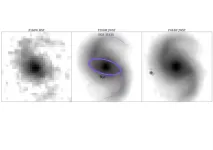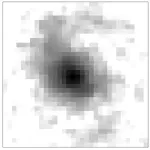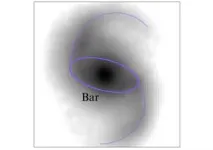(Press-News.org) Embargoed until 00:01am BST on Wednesday 24 April 2024/19.01pm ET on Tuesday 23 April 2024
-With pictures-
The Universe’s early galaxies were less chaotic and developed much faster than previously thought, according to new research looking back more than ten billion years in time.
An international team of astronomers led by Durham University, UK, used the James Webb Space Telescope (JWST) to find evidence of bar formation when the Universe was only a few billion years old.
Bars are elongated strips of stars found in disc or spiral galaxies like our Milky Way.
As bars develop, they regulate star formation within a galaxy, pushing gas into the galaxy’s central region, and their presence tells scientists that galaxies have entered a settled, mature phase.
Previous studies carried out using the Hubble Space Telescope had been able to detect bar forming galaxies up to eight or nine billion years ago.
But the increased sensitivity and wavelength range offered by the JWST means researchers have been able to see the phenomenon happening even further back in time.
This means scientists might have to rethink their theories about galaxy evolution in the early stages of the Universe’s formation.
The latest research is published in the journal Monthly Notices of the Royal Astronomical Society.
Lead author Zoe Le Conte, a PhD researcher in the Centre for Extragalactic Astronomy, Department of Physics, Durham University, said: “Galaxies in the early Universe are maturing much faster than we thought.
“This is a real surprise because you would expect the Universe at that stage to be very turbulent with lots of collisions between galaxies and a lot of gas that hasn’t yet transformed into stars.
“However, thanks to the James Webb Space Telescope we are seeing a lot of these bars much earlier in the life of the Universe which means that galaxies were at a more settled stage in their evolution than previously thought.
“This means we will have to adjust our views on early galaxy evolution.”
The researchers used the JWST to look for bar formation in galaxies as they would have been seen between eight to 11.5 billion years ago. The Universe itself is 13.7 billion years old.
Of 368 disc galaxies observed, the researchers saw that almost 20 per cent had bars – twice as many than observed by Hubble.
Co-author Dr Dimitri Gadotti, in the Centre for Extragalactic Astronomy, Department of Physics, Durham University, said: “We find that many more bars were present in the early Universe than previously found in Hubble studies, implying that bar-driven galaxy evolution has been happening for much longer than previously thought.
“The fact that there are a lot more bars is what’s very exciting.
“The simulations of the Universe now need to be scrutinised to see if we get the same results as the observations we’ve made with James Webb.
“We have to think outside of what we thought we knew.”
As the researchers looked further back in time, they were able to see fewer and fewer bar-forming galaxies.
They say this might be because galaxies at an even earlier stage of the Universe might not be as well formed. There is also currently no way to see shorter bars of stars, which are less easy to spot, even with the increased telescopic power offered by the JWST.
The researchers say they now want to investigate even more galaxies in the early Universe to see if they have also formed bars. They hope to eventually look further back in time – 12.2 billion years – to look at bar-growth over time and what the mechanisms are behind this growth.
The JWST is the replacement for the Hubble Space Telescope and is the largest, most powerful space telescope ever built.
Durham University’s Centre for Extragalactic Astronomy was involved in the telescope’s scientific development, including the Mid-Infrared Instrument (MIRI), which is used to probe galaxies and black holes.
Durham’s Centre for Advanced Instrumentation also made some of the optics for the JWST’s Near Infrared Spectrograph’s (NIRSpec) Integral Field Unit instrument.
The latest study also included scientists from Durham University’s Institute for Computational Cosmology, University of Victoria, Canada; Jodrell Bank Centre for Astrophysics – University of Manchester, UK; the European Southern Observatory; the Department of Astronomy and Atmospheric Sciences, Kyungpook National University, Republic of Korea; the Max Planck Institute for Astronomy, Germany; Aix Marseille University, France.
The research was funded in the UK by the UKRI-Science and Technology Facilities Council.
ENDS
END
Star bars show Universe’s early galaxies evolved much faster than previously thought
2024-04-24
ELSE PRESS RELEASES FROM THIS DATE:
Critical minerals recovery from electronic waste
2024-04-24
RICHLAND, Wash.—There’s some irony in the fact that devices that seem indispensable to modern life—mobile phones, personal computers, and anything battery-powered—depend entirely on minerals extracted from mining, one of the most ancient of human industries. Once their usefulness is spent, we typically return these objects to the Earth in landfills, by the millions.
But what if we could “mine” electronic waste (e-waste), recovering the useful minerals contained within them, instead of throwing them away? A clever method of recovering valuable minerals from e-waste, developed by a research team at the Department ...
The move by Apple Memories to block potentially upsetting content illustrates Big Tech’s reach and limits, writes Chrys Vilvang
2024-04-23
How do algorithms determine the way we interact with our memories?
It’s a uniquely 21st-century kind of question, and it is far from settled.
In a new paper in the journal Memory, Mind & Media, Concordia PhD candidate Chrys Vilvang argues that the way tech companies store, package and share personal content back to users is opaque. And, given one recent controversy, it’s open to important questions about selection and representation.
Vilvang’s paper looks at the discussion stemming from an April 2022 article on 9to5Mac, a tech news site dedicated to all things Apple. Its journalists were given access to the iOS 15.5 beta update, and they discovered ...
Chemical tool illuminates pathways used by dopamine, opioids and other neuronal signals
2024-04-23
Image
University of Michigan researchers have developed a new tool to better understand how chemicals like dopamine and epinephrine interact with neurons.
These chemicals are among a wide variety of signals that get processed in the brain through G protein-coupled receptors (GPCRs), proteins that sit on the surface of neurons to receive messages—in the forms of proteins, sugars, fats, even light—that inform cellular behavior.
GPCRs are involved in an enormous number of biological functions, making them a prime ...
Asian monsoon lofts ozone-depleting substances to stratosphere
2024-04-23
Asian monsoon lofts ozone-depleting substances to stratosphere
Airborne observations discover new link between pollution and climate
Powerful monsoon winds, strengthened by a warming climate, are lofting unexpectedly large quantities of ozone-depleting substances high into the atmosphere over East Asia, new research shows.
The study, led by the U.S. National Science Foundation National Center for Atmospheric Research (NSF NCAR) and NASA, found that the East Asian Monsoon delivers more than twice the concentration of very short-lived ozone-depleting substances into the upper troposphere and lower stratosphere than previously reported.
The research team ...
PET scans reveal ‘smoldering’ inflammation in patients with multiple sclerosis
2024-04-23
A Brigham and Women’s Hospital study of 30 people found that, in patients with MS, advanced brain imaging could identify hidden inflammation not picked up on traditional MRIs
The new technique could lead to more advanced treatments for multiple sclerosis
A new study from Brigham and Women’s Hospital, a founding member of the Mass General Brigham healthcare system, suggests positron emission tomography (PET) brain scans could reveal hidden inflammation in patients with multiple sclerosis (MS) who are being treated with highly-effective treatments. The findings were published ...
Genetics predict type 2 diabetes risk and disparities in childhood cancer survivors
2024-04-23
(MEMPHIS, Tenn. – April 23, 2024) Survivors of childhood cancer are at increased risk for cardiovascular disease, for which a risk factor is their greater prevalence of type 2 diabetes, with a disproportionate impact on those of non-European heritage. St. Jude Children’s Research Hospital scientists have identified four previously unknown genetic variants associated with diabetes risk in all survivors. Published today in the Journal of Clinical Oncology, their work also found an association between a previously ...
Health information on TikTok: The good, the bad and the ugly
2024-04-23
In today's digital age, social media platforms like TikTok have become integral parts of our lives, offering not just entertainment and catchy dances but also a wealth of information on topics ranging from home improvement to world news. According to some reports, many young people even prefer to use social media in place of traditional search engines like Google when looking for answers.
Health information is no exception. Hashtags like #celiactok, #diabetestok and #sinustok have millions of views, with each tag leading to countless videos about each health issue.
“Every type of ‘Tok’ exists – that’s just ...
New study points to racial and social barriers that block treatment for multiple myeloma
2024-04-23
A UC Davis Health study reveals persistent racial and social disparities preventing access to autoHCT, a common bone marrow transplant treatment to halt the progression of multiple myeloma.
An analysis of data from three California health care organizations, published in Clinical Lymphoma, Myeloma & Leukemia, showed that Black myeloma patients were less likely to receive autoHCT. This was despite having a greater risk of developing the cancer than other racial or ethnic groups. Patients using Medicaid, Medicare, or no insurance in California also accessed the treatment less than those with other insurance ...
Rensselaer researcher finds that frog species evolved rapidly in response to road salts
2024-04-23
When we think of evolution, we think of a process that happens over hundreds or thousands of years. In research recently published, a team led by Rick Relyea, Ph.D., professor of biological sciences and David M. Darrin ’40 Senior Endowed Chair at Rensselaer Polytechnic Institute, found a species of frog that has evolved over the course of merely 25 years. The adaptation was spurred on by something many assume is innocuous: salt.
“We’ve been applying de-icing salts to reduce car accidents in snowy and icy conditions in the United States for 80 years, and we currently apply four times more road salt than we did ...
A new chapter in quantum vortices: Customizing electron vortex beams
2024-04-23
A new publication from Opto-Electronic Advances; DOI 10.29026/oea.2024.230184 , discusses tailoring electron vortex beams with customizable intensity patterns by electron diffraction holography.
In recent years, the scientific community has witnessed a notable breakthrough in the study and development of electron vortices. Electron vortices are electron beams that carry orbital angular momentum, meaning the electrons move not only in their propagation direction but also rotate in a vortex-like manner. This unique characteristic offers many new physical properties and potential applications, making it a powerful ...







